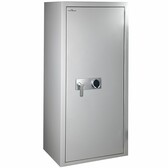Locks on safes are devices that guarantee security. It is virtually impossible for unauthorised people to open them. However, even authorised users may have problems opening the door. Some types of locks are complicated to operate, while others are trivial. Find out how the different types of locks are opened, how to open a safe without batteries and what to do in an emergency.
How do you open a safe without batteries?
Electronic locks with a numeric keypad are powered by batteries. In some types, replacing them is quite easy as you simply pull off the front panel. Remember to prepare spare batteries in advance.
However, there are some lock models in which the batteries can only be changed when the door is opened. How do I change the batteries in a safe with such a lock? The best thing to do, of course, is to do it before they run down. The indicator light on the lock should indicate the battery level.
However, if you have not had time to replace the batteries, you will need an external power source. You will only be able to change the batteries in the safe once you have inserted a 9-volt battery in a special place on the panel.
Your lock can also be fitted with a special cable for emergency opening. Replacing the battery in this type of safe involves connecting the cable to the lock. The other end of the cable is applied to the battery listed in the manual.
Emergency opening of safes
You have already found out how to open a safe without batteries, but other problems can arise. What do you do if you have received an armoured safe box as an inheritance and don't know what the cipher is? There are also cases where the code is simply forgotten. Some types of locks require a constant power supply from the mains and in the event of a power failure they cannot be opened. What do you do then?
If you don't know what the lock cipher is, it is best to contact the manufacturer. Of course, you can also call a locksmith. Unfortunately, an inexperienced workman can destroy the safe, which will only be suitable for disposal. When you have a problem with your safe deposit box, want to open it in an emergency and not destroy the safe, call the specialists at Hartmann Tresore.
Fingerprint reader locks require constant power supply from the mains. In the event of a power failure, you will not be able to open the safe in the traditional way. These types of locks are equipped with a revision, i.e. the ability to open with a key. Check the instructions to see where this is located.
How to open the different types of safe locks?
The simplest one is, of course, the key lock. Before opening the door, however, it is worth checking the condition of the mechanism. See if there is a foreign object in it. Also inspect the key. If it is chipped or bent, you may have a problem opening the safe.
Changing the battery in an electronic safe is simple. Once this is done, simply enter the code on the numeric keypad, confirm with an enter or a cross and the door is open.
Opening biometric safes is even simpler. Put your fingerprint on the reader and wait for the mechanism to open. Remember, however, that both your finger and the reader must be clean. Also watch out for injuries to your finger, as even a minor cut will prevent the lock from opening.
The most complex opening mechanism has a mechanical lock with a traditional knob. This security features a high degree of security, but opening requires precision.
The dial lock consists of two dials. On the rotating one, there are one hundred graduations. On the stationary one there are two dashes. The one at twelve o'clock is used to open the lock and the one on the left to change the cipher.
Entering a three-number code requires concentration and accuracy. For this operation you will need to make four clockwise turns, three counterclockwise, two clockwise and one counterclockwise turns. Finally, turn the dial to the right as far as it will go and open the safe.
Check also: Opening different types of locks on safes
How do I use my safe to last as long as possible?
Changing the batteries in a safe is not the only maintenance task. The armoured cabinet should be cleaned regularly. Use mild detergents for this purpose. Chlorine-based agents can damage the paint finish. To remove difficult dirt, you would be better off using extraction gasoline. Remember that damage to the safe will void the guarantee.
Do not interfere with the lock mechanism, hinges or bolts. Any repairs on your own are not advisable. If you think something is malfunctioning, contact a service centre. Attempting to fix the fault yourself could lead to irreparable damage.
However, if your office safe has suffered a serious malfunction that cannot be rectified, it is best to dispose of it. The old safe will be taken away by the service and you can use a replacement safe until a new model is delivered.
Opening the lock even in an emergency does not have to be difficult. Replacing the batteries in the safe on a regular basis will ensure that you always have trouble-free access to the inside. Use the safe according to the manufacturer's instructions and recommendations and it will certainly serve you for a long time.





